Effects of Ion Irradiation and Temperature on Mechanical Properties of GaN Single Crystals under Nanoindentation
Abstract
1. Introduction
2. Materials and Methods
2.1. Sample Preparation
2.2. Nanoindentation Procedure and Analysis
3. Results
3.1. Effects of Temperature and Ion Irradiation on Pop-In Load
3.2. Effects of Temperature and Ion Irradiation on Young’s Modulus
3.3. Effects of Temperature and Ion Irradiation on Hardness
3.4. Effects of Temperature and Ion Irradiation on Fracture
4. Conclusions
Author Contributions
Funding
Institutional Review Board Statement
Informed Consent Statement
Data Availability Statement
Conflicts of Interest
References
- Mukai, T.; Nakamura, S. Ultraviolet InGaN and GaN single-quantum-well-structure light-emitting diodes grown on epitaxially laterally overgrown GaN substrates. Jpn. J. Appl. Phys. 1999, 38, 5735. [Google Scholar] [CrossRef]
- Pearton, S.J.; Zolper, J.C.; Shul, R.J.; Ren, F. GaN: Processing; defects; devices. J. Appl. Phys. 1999, 86, 1–78. [Google Scholar] [CrossRef]
- Polyakov, A.Y.; Pearton, S.J.; Frenzer, P.; Ren, F.; Liu, L.; Kim, J. Radiation effects in GaN materials and devices. J. Mater. Chem. C 2013, 1, 877. [Google Scholar] [CrossRef]
- Chen, X.; Zhou, W.; Zhang, X.; Feng, Q.; Zheng, J.; Liu, X.; Tang, B.; Li, J.; Xue, J.; Peng, S. Mechanical properties of 6H-SiC irradiated by neutron and MeV heavy ions: A nanoindentation and finite element method study. J. Appl. Phys. 2018, 123, 025104. [Google Scholar] [CrossRef]
- Gouldstone, A.; Chollacoop, N.; Dao, M.; Li, J.; Minor, A.M.; Shen, Y.L. Indentation across size scales and disciplines: Recent developments in experimentation and modeling. Acta Mater. 2007, 55, 4015. [Google Scholar] [CrossRef]
- Xiao, X.; Yu, L. Nano-indentation of ion-irradiated nuclear structural materials: A review. Nucl. Mater. Energy 2020, 22, 100721. [Google Scholar] [CrossRef]
- Gorji, N.E.; O’Connor, R.; Brabazon, D. X-ray tomography, AFM and nanoindentation measurements for recyclability analysis of 316L powders in 3D printing process. Procedia Manuf. 2020, 47, 1113. [Google Scholar] [CrossRef]
- Kavouras, P.; Katsikini, M.; Vouroutzis, N.; Lioutas, C.B.; Paloura, E.C.; Antonopoulos, J.; Karakostas, T. Ion implantation effects on the microhardness and microstructure of GaN. J. Cryst. Growth 2001, 230, 454. [Google Scholar] [CrossRef]
- Kavouras, P.; Katsikini, M.; Kehagias, T.; Paloura, E.C.; Komninou, P.; Antonopoulos, J.; Karakostas, T. A parametric study of implantation-induced variations on the mechanical properties of epitaxial GaN. J. Phys. Condens. Matter. 2002, 14, 12953. [Google Scholar] [CrossRef]
- Kucheyev, S.O.; Bradby, J.E.; Williams, J.S.; Jagadish, C.; Swain, M.V.; Li, G. Deformation behavior of ion-beam-modified GaN. Appl. Phys. Lett. 2001, 78, 156. [Google Scholar] [CrossRef]
- Jian, S.-R.; Fang, T.-H.; Chuu, D.-S. Nanomechanical characterizations of InGaN thin films. Appl. Surf. Sci. 2006, 252, 3033. [Google Scholar] [CrossRef]
- Eve, S.; Moisy, F.; Germanicus, R.C.; Grygiel, C.; Hug, E.; Monnet, I. Caractérisation par nanoindentation du GaN irradié par des ions uranium de grandeénergie. Matér. Tech. 2017, 105, 108. [Google Scholar] [CrossRef][Green Version]
- Dong, Z.; Zhang, X.; Peng, S.; Jin, F.; Wan, Q.; Ming, J.; Yi, X. Mechanical properties of GaN single crystals upon C ion irradiation: Nanoindentation analysis. Materials 2022, 15, 1210. [Google Scholar] [CrossRef]
- Yonenage, I.; Hoshi, T.; Usui, A. High temperature hardness of bulk single crystal GaN. MRS Internet J. Nitride Semicond. Res. 2000, 5, 343. [Google Scholar] [CrossRef]
- Lu, J.; Ren, H.; Deng, D.; Wang, Y.; Chen, K.J.; Lau, K.; Zhang, T. Thermally activated pop-in and indentation size effects in GaN films. J. Phys. D 2012, 45, 085301. [Google Scholar] [CrossRef]
- Wheeler, J.M.; Niederberger, C.; Tessarek, C.; Christiansen, S.; Michler, J. Extraction of plasticity parameters of GaN with high temperature, in situ micro-compression. Int. J. Plast. 2013, 40, 140. [Google Scholar] [CrossRef]
- Qian, Y.; Shang, F.; Wan, Q.; Yan, Y. The mechanism of plastic deformation in intact and irradiated GaN during indentation: A molecular dynamics study. Comput. Mater. Sci. 2018, 149, 230. [Google Scholar] [CrossRef]
- Guo, J.; Chen, J.; Wang, Y. Temperature effect on mechanical response of c-plane monocrystalline gallium nitride in nanoindentation: A molecular dynamics study. Ceram. Int. 2020, 46, 12686. [Google Scholar] [CrossRef]
- Ziegler, J.F.; Ziegler, M.D.; Biersack, J.P. SRIM-the stopping and range of ions in matter. Nucl. Instrum. Methods Phys. Res. B 2010, 268, 1818. [Google Scholar] [CrossRef]
- Stoller, R.E.; Toloczko, M.B.; Was, G.S.; Certain, A.G.; Dwaraknath, S.; Garner, F.A. On the use of SRIM for computing radiation damage exposure. Nucl. Instrum. Methods Phys. Res. B 2013, 310, 75. [Google Scholar] [CrossRef]
- Hangen, B.U.; Chen, C.; Richter, A. Mechanical characterization of PM2000 oxide-dispersion-strengthened alloy by high temperature nanoindentation. Adv. Eng. Mater. 2015, 17, 1683. [Google Scholar] [CrossRef]
- Broitman, E.; Tengdelius, L.; Hangen, U.D.; Lu, J.; Hultman, L.; Högberg, H. High-temperature nanoindentation of epitaxial ZrB2 thin films. Scr. Mater. 2016, 124, 117. [Google Scholar] [CrossRef]
- ISO 14577—1:2015; Metallic Materials—Instrumented Indentation Test for Hardness and Materials Parameters—Part 1: Test method. ISO: Geneva, Switzerland, 2015.
- Li, Y.; Fang, X.; Xia, B.; Feng, X. In situ measurement of oxidation evolution at elevated temperature by nanoindentation. Scr. Mater. 2015, 103, 61. [Google Scholar] [CrossRef]
- Oliver, W.C.; Pharr, G.M. An improved technique for determining hardness and elastic modulus using load and displacement sensing indentation experiments. J. Mater. Res. 1992, 7, 1564. [Google Scholar] [CrossRef]
- King, R.B. Elastic analysis of some punch problems for a layered medium. Int. J. Solids Struct. 1987, 23, 1657. [Google Scholar] [CrossRef]
- Nowak, R.; Pessa, M.; Suganuma, M.; Leszczynski, M.; Grzegory, I.; Porowski, S.; Yoshida, F. Elastic and plastic properties of GaN determined by nano-indentation of bulk crystal. Appl. Phys. Lett. 1999, 75, 2070. [Google Scholar] [CrossRef]
- Kese, K.O.; Li, Z.C.; Bergman, B. Method to account for true contact area in soda-lime glass during nanoindentation with the Berkovich tip. Mater. Sci. Eng. A 2005, 404, 1–8. [Google Scholar] [CrossRef]
- Kavouras, P.; Ratschinski, I.; Dimitrakopulos, G.P.; Leipner, H.S.; Komninou, P.; Leibiger, G.; Habel, F. Deformation and fracture in (0001) and (10-10) GaN single crystals. Mater. Sci. Technol. 2018, 34, 1531–1538. [Google Scholar] [CrossRef]
- Huang, J.; Xu, K.; Fan, Y.M.; Wang, J.F.; Zhang, J.C.; Ren, G.Q. Dislocation luminescence in GaN single crystals under nanoindentation. Nanoscale Res. Lett. 2014, 9, 649. [Google Scholar] [CrossRef] [PubMed]
- Jian, S.-R.; Juang, J.-Y. Nanoindentation-induced pop-in effects in GaN thin films. IEEE Trans. Nanotechnol. 2013, 12, 304. [Google Scholar] [CrossRef]
- Bradby, J.; Williams, J.; Swain, M. Pop-in events induced by spherical indentation in compound semiconductors. J. Mater. Res. 2004, 19, 380. [Google Scholar] [CrossRef]
- Jian, S.-R. Berkovich indentation-induced deformation behaviors of GaN thin films observed using cathodoluminescence and cross-sectional transmission electron microscopy. Appl. Surf. Sci. 2008, 254, 6749. [Google Scholar] [CrossRef]
- Nix, W.D.; Gao, H. Indentation size effects in crystalline materials: A law for strain gradient plasticity. J. Mech. Phys. Solids 1998, 46, 411. [Google Scholar] [CrossRef]
- Wang, R.; Fang, Q.F. Core structure and mobility of an edge dislocation in aluminum. J. Alloys Compd. 2000, 310, 80. [Google Scholar] [CrossRef]
- Fang, Q.F.; Wang, R. Atomistic simulation of the atomic structure and diffusion within the core region of an edge dislocation in aluminum. Phys. Rev. B 2000, 62, 9317. [Google Scholar] [CrossRef]
- Liu, W.; Chen, L.; Cheng, Y.; Yu, L.; Yi, X.; Gao, H.; Duan, H. Model of nanoindentation size effect incorporating the role of elastic deformation. J. Mech. Phys. Solids 2019, 126, 245. [Google Scholar] [CrossRef]
- Huang, J.; Xu, K.; Gong, X.J.; Wang, J.F.; Fan, Y.M.; Liu, J.Q.; Zeng, X.H.; Ren, G.Q.; Zhou, T.F.; Yang, H. Dislocation cross-slip in GaN single crystals under nanoindentation. Appl. Phys. Lett. 2011, 98, 221906. [Google Scholar] [CrossRef]
- Qiu, X.; Huang, Y.; Nix, W.D.; Hwang, K.C.; Gao, H. Effect of intrinsic lattice resistance in strain gradient plasticity. Acta Mater. 2001, 49, 3949. [Google Scholar] [CrossRef]
- Qian, Y.; Shang, F.; Wan, Q.; Yan, Y. A molecular dynamics study on indentation response of single crystalline wurtzite GaN. J. Appl. Phys. 2018, 124, 115102. [Google Scholar] [CrossRef]
- Han, S.M.; Feng, G.; Jung, J.Y.; Jung, H.J.; Groves, J.R.; Nix, W.D.; Cui, Y. Critical-temperature/Peierls-stress dependent size effects in body centered cubic nanopillars. Appl. Phys. Lett. 2013, 102, 041910. [Google Scholar] [CrossRef]
- Wheeler, J.M.; Michler, J. Indenter materials for high temperature nanoindentation. Rev. Sci. Instrum. 2013, 84, 101301. [Google Scholar] [CrossRef] [PubMed]
- Xiao, X.; Terentyev, D.; Ruiz, A.; Zinovev, A.; Bakaev, A.; Zhurkin, E.E. High temperature nano-indentation of tungsten: Mod-elling and experimental validation. Mater. Sci. Eng. A 2019, 743, 106. [Google Scholar] [CrossRef]
- Tromas, C.; Audurier, V.; Leclerc, S.; Beaufort, M.F.; Declémy, A.; Barbot, J.F. Evolution of mechanical properties of SiC under helium implantation. J. Nucl. Mater. 2008, 33, 142. [Google Scholar] [CrossRef]
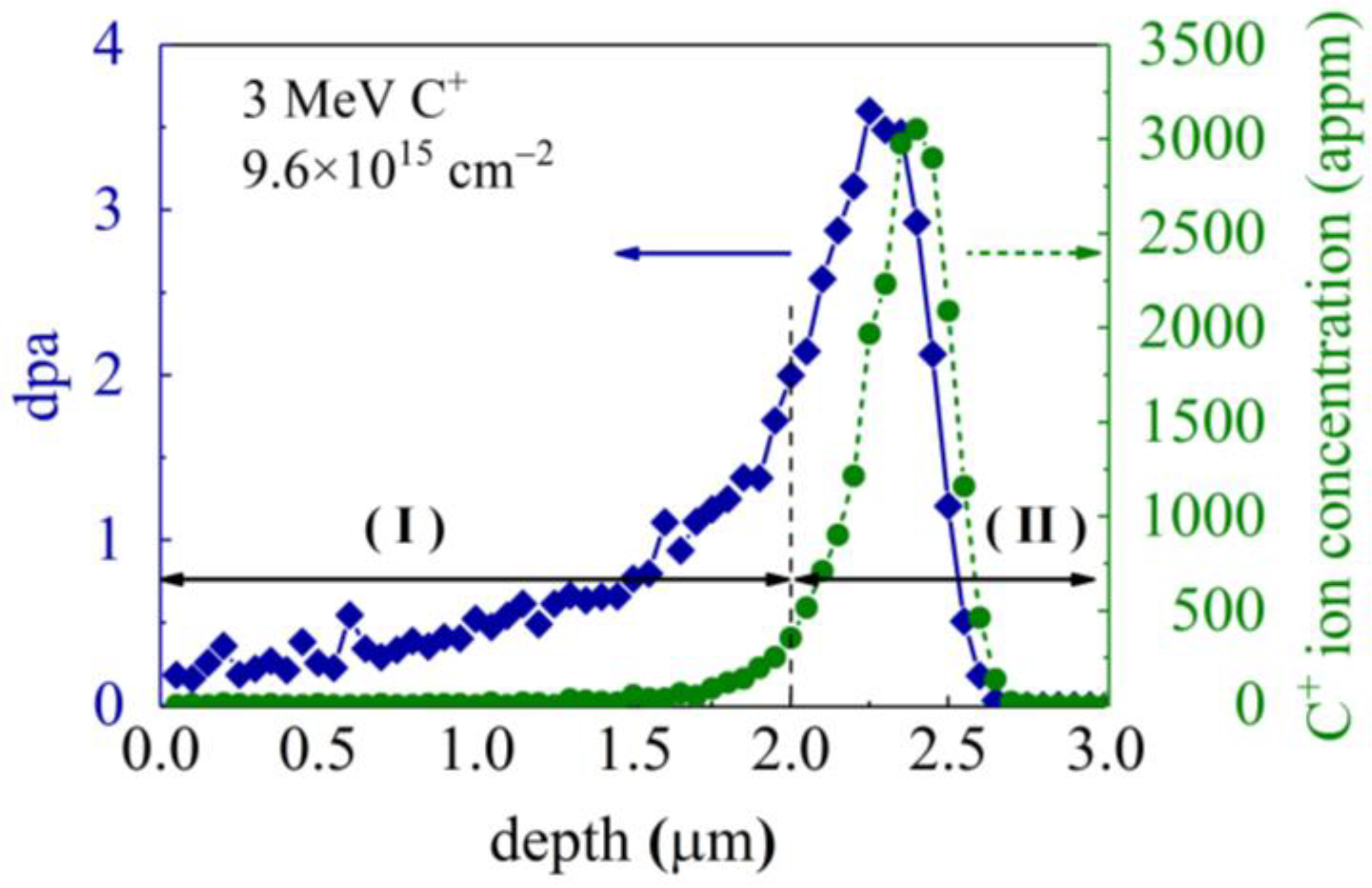
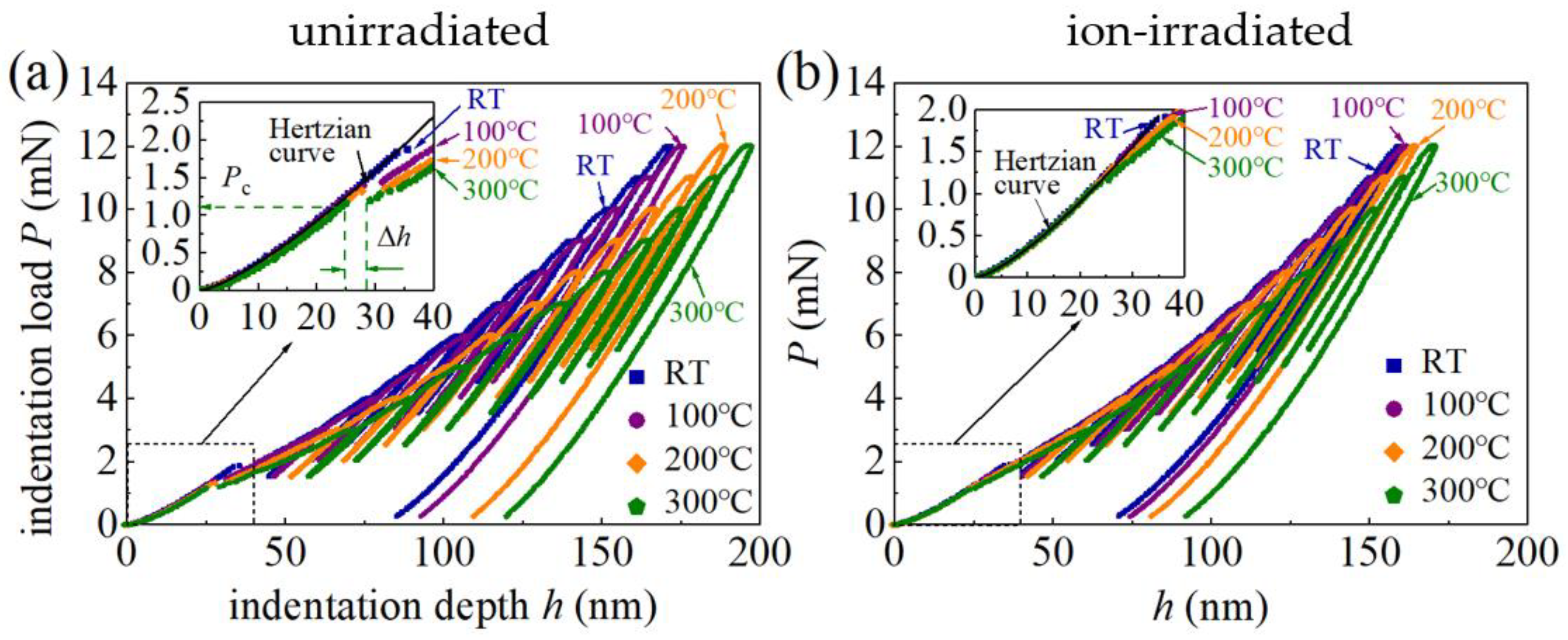

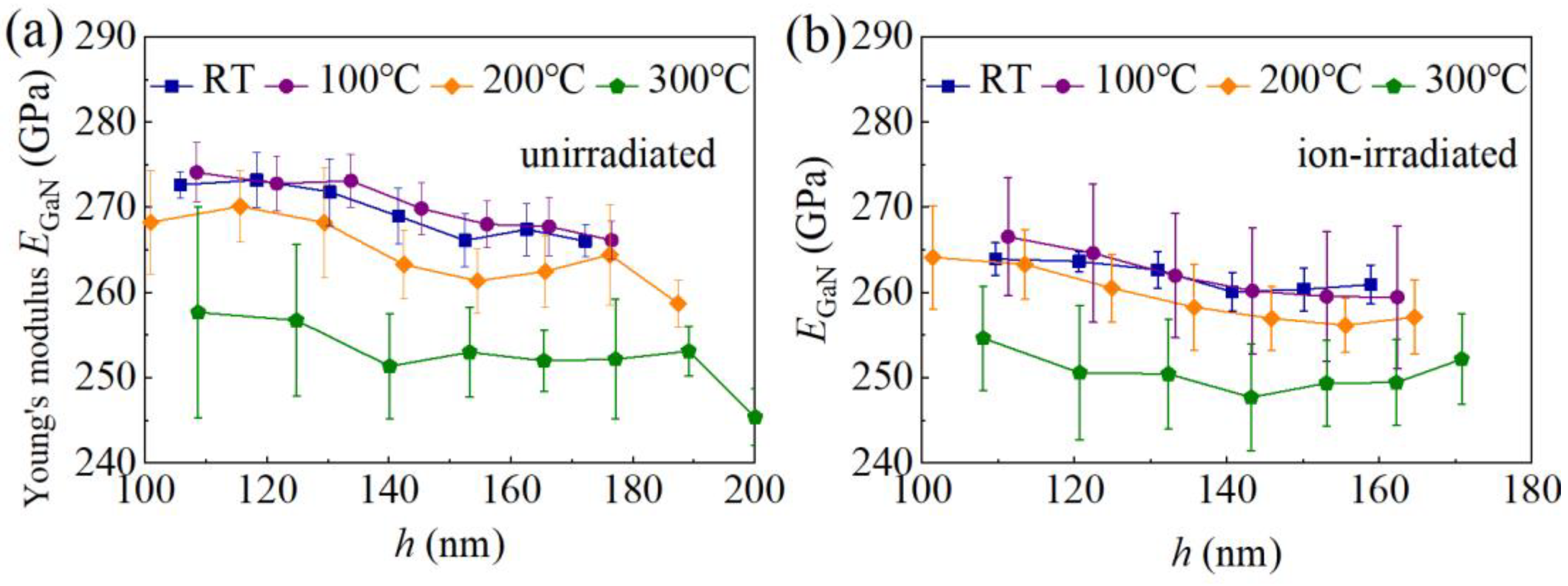
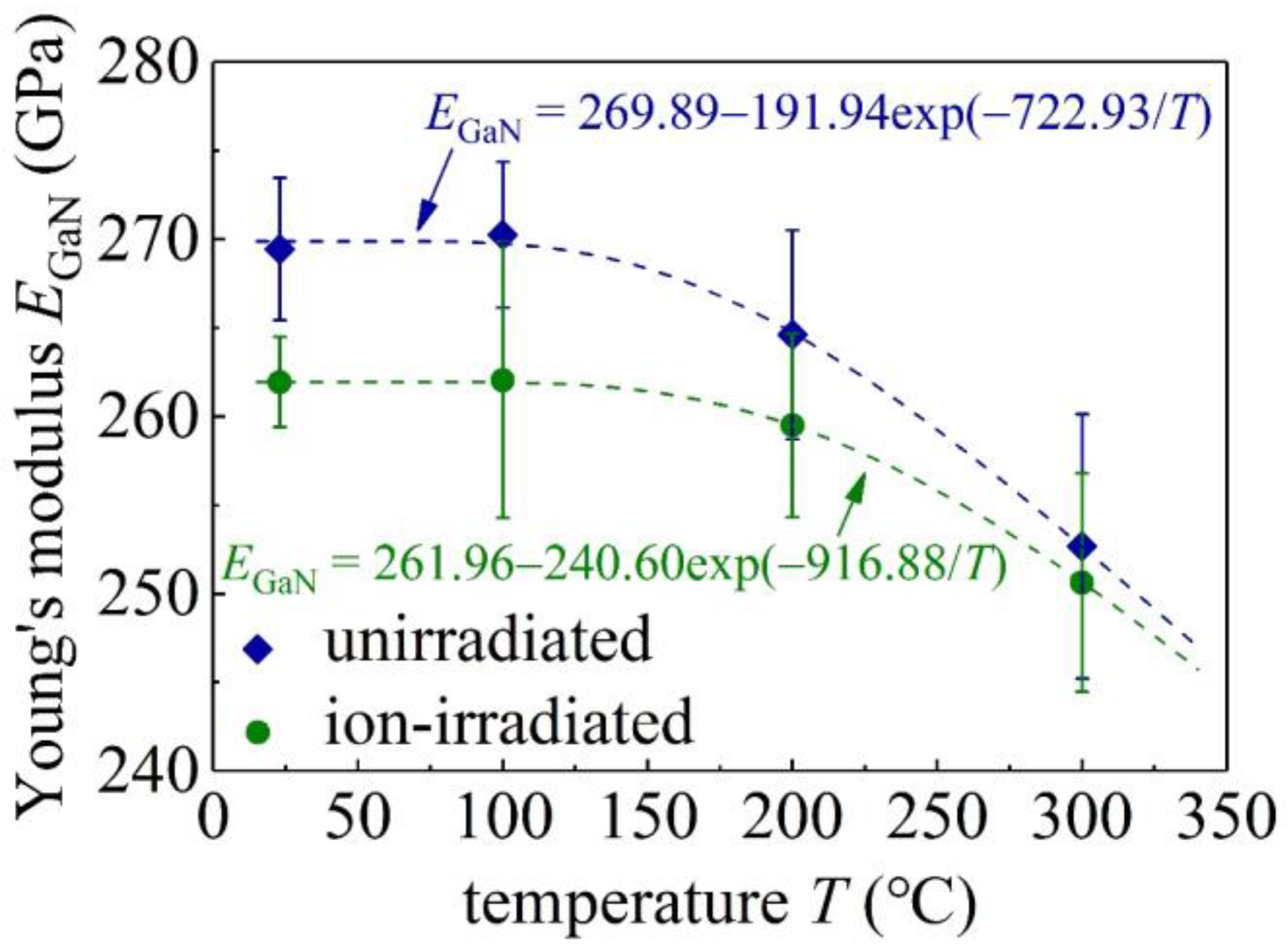
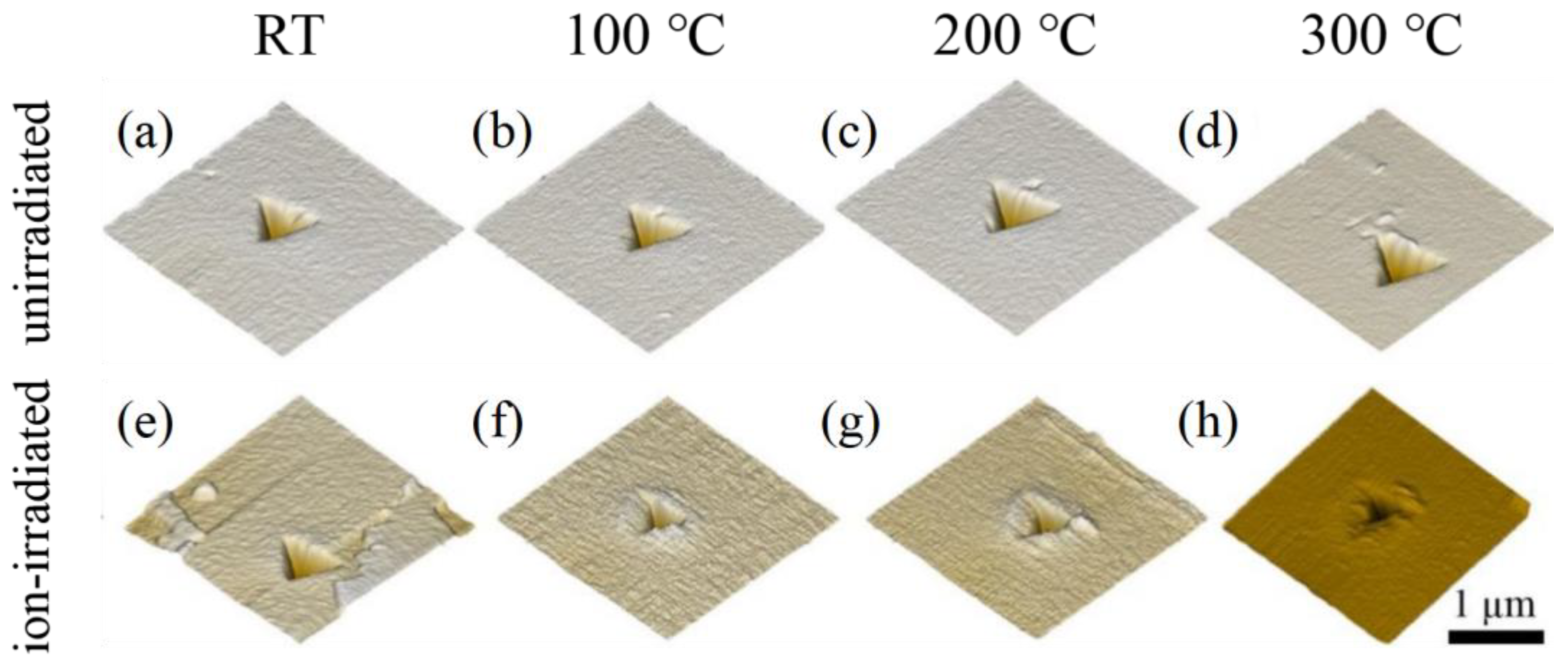
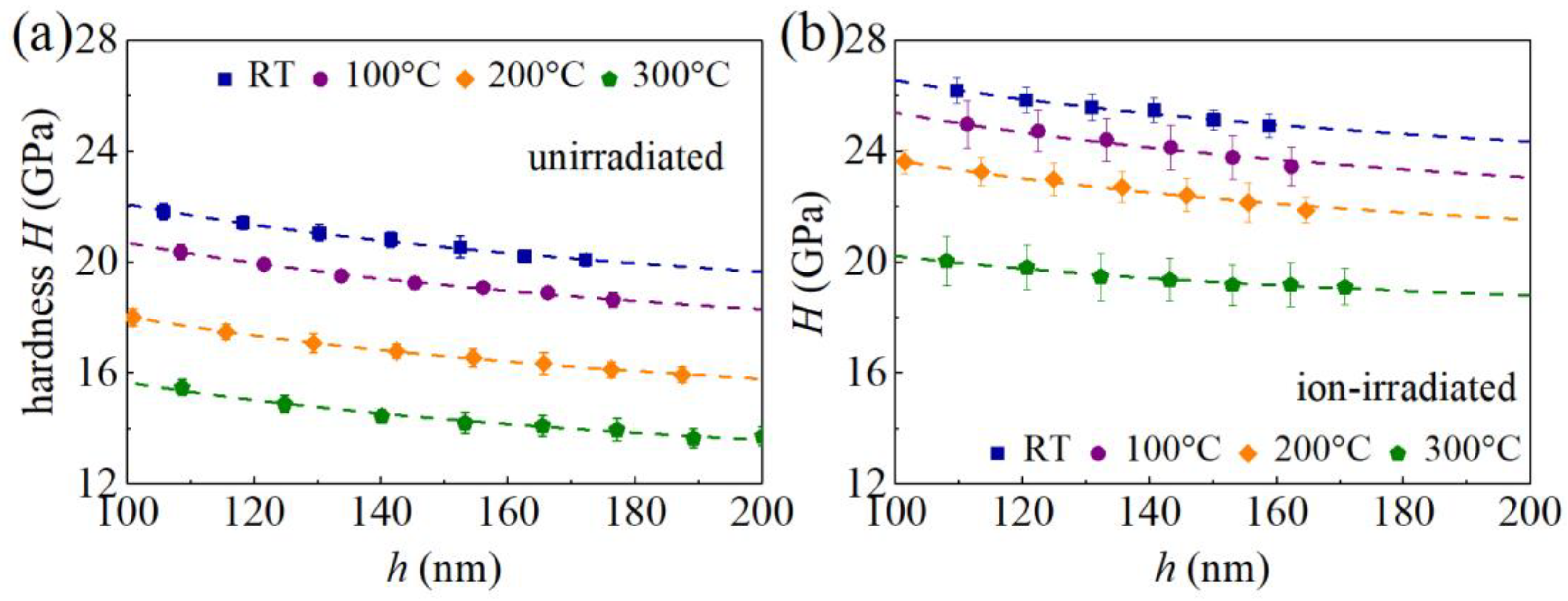
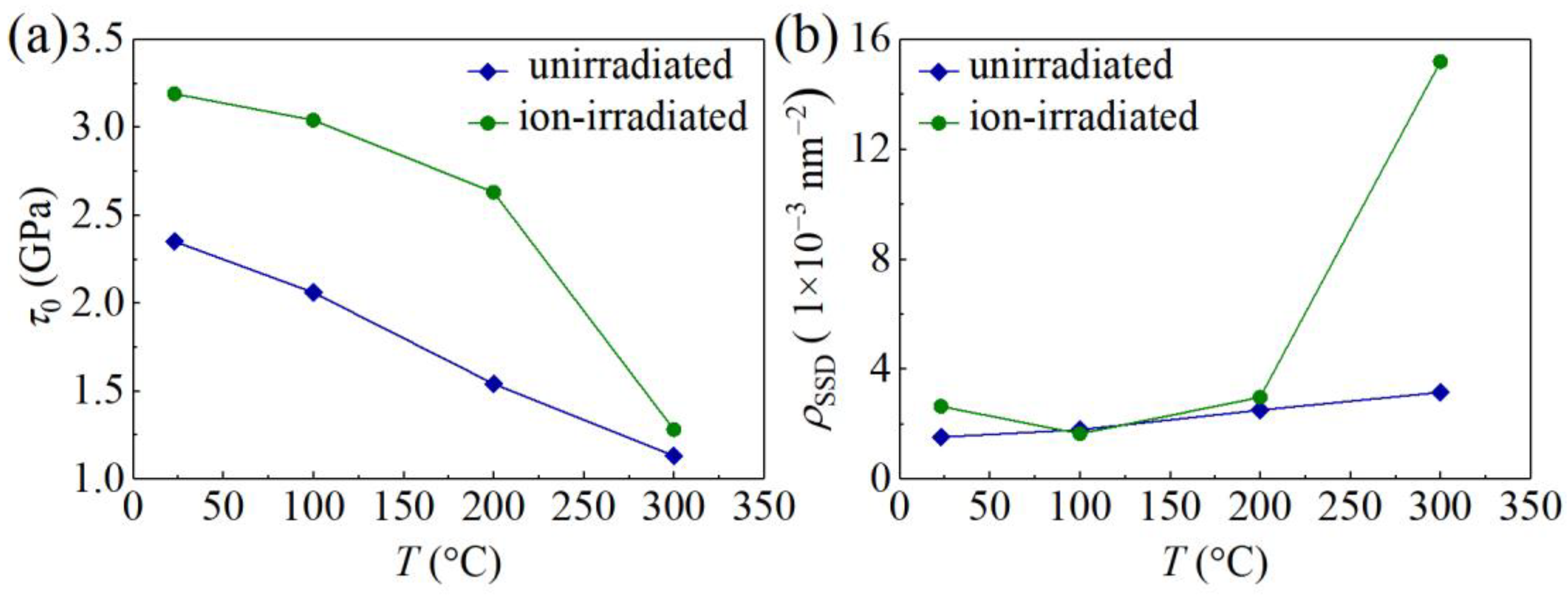

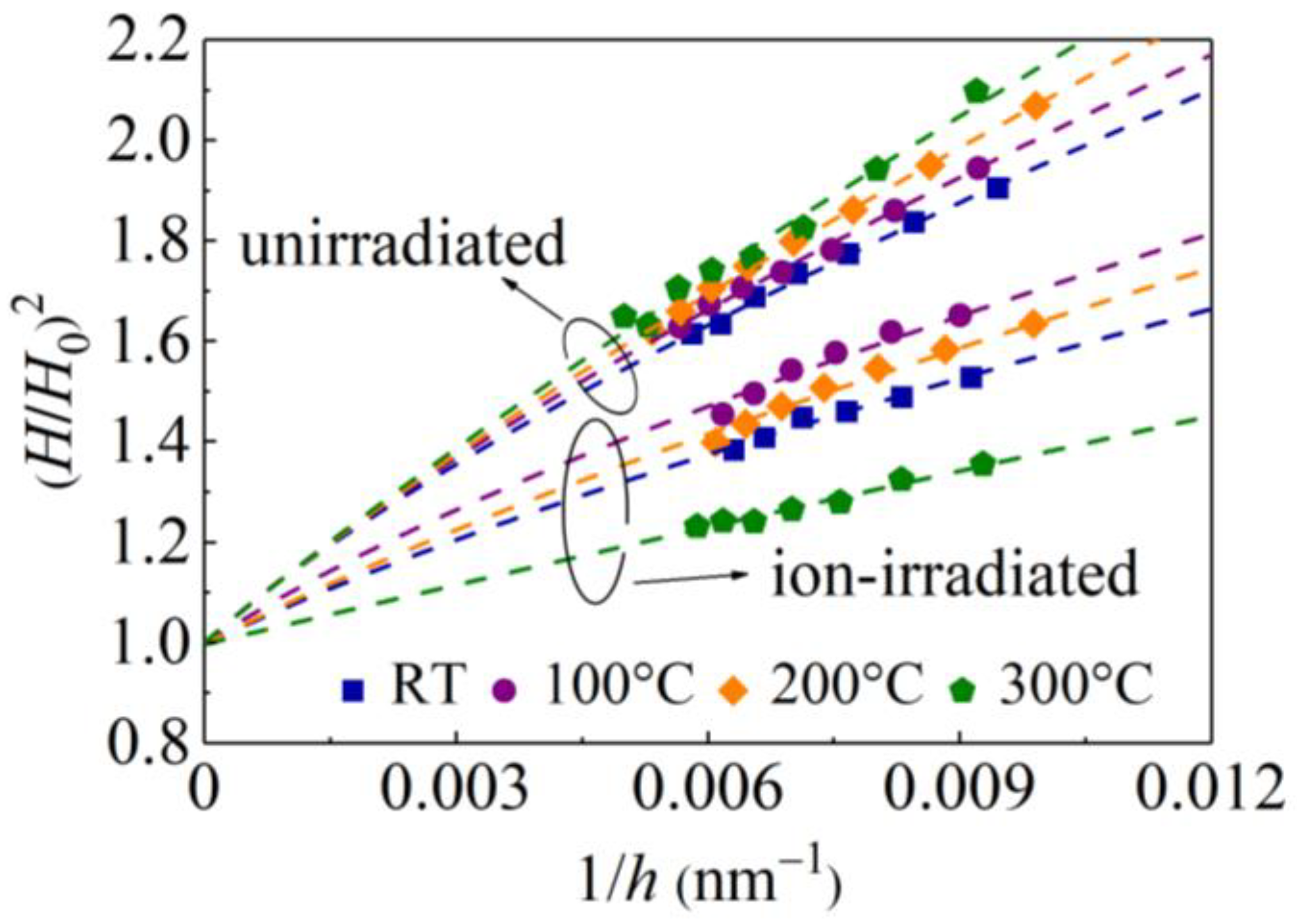

| T (°C) | Unirradiated | Ion-Irradiated | ||||||
|---|---|---|---|---|---|---|---|---|
| Pc (mN) | EGaN (GPa) | H0 (GPa) | h* (nm) | Pc (mN) | EGaN (GPa) | H0 (GPa) | h* (nm) | |
| RT | 1.77 ± 0.31 | 269.5 ± 3.1 | 15.81 | 33.89 | 1.80 ± 0.31 | 261.9 ± 1.7 | 21.16 | 17.58 |
| 100 | 1.43 ± 0.17 | 270.2 ± 3.1 | 14.60 | 39.70 | 1.73 ± 0.39 | 262.1 ± 2.9 | 19.42 | 20.87 |
| 200 | 1.28 ± 0.22 | 264.6 ± 3.9 | 12.52 | 51.18 | 1.57 ± 0.50 | 259.5 ± 3.2 | 18.47 | 22.65 |
| 300 | 1.12 ± 0.39 | 252.7 ± 3.7 | 10.68 | 63.90 | 1.42 ± 0.50 | 250.6 ± 2.2 | 17.19 | 24.62 |
Disclaimer/Publisher’s Note: The statements, opinions and data contained in all publications are solely those of the individual author(s) and contributor(s) and not of MDPI and/or the editor(s). MDPI and/or the editor(s) disclaim responsibility for any injury to people or property resulting from any ideas, methods, instructions or products referred to in the content. |
© 2023 by the authors. Licensee MDPI, Basel, Switzerland. This article is an open access article distributed under the terms and conditions of the Creative Commons Attribution (CC BY) license (https://creativecommons.org/licenses/by/4.0/).
Share and Cite
Dong, Z.; Zhang, X.; Li, J.; Peng, S.; Wan, Q.; Xue, J.; Yi, X. Effects of Ion Irradiation and Temperature on Mechanical Properties of GaN Single Crystals under Nanoindentation. Materials 2023, 16, 7537. https://doi.org/10.3390/ma16247537
Dong Z, Zhang X, Li J, Peng S, Wan Q, Xue J, Yi X. Effects of Ion Irradiation and Temperature on Mechanical Properties of GaN Single Crystals under Nanoindentation. Materials. 2023; 16(24):7537. https://doi.org/10.3390/ma16247537
Chicago/Turabian StyleDong, Zhaohui, Xiuyu Zhang, Jiling Li, Shengyuan Peng, Qiang Wan, Jianming Xue, and Xin Yi. 2023. "Effects of Ion Irradiation and Temperature on Mechanical Properties of GaN Single Crystals under Nanoindentation" Materials 16, no. 24: 7537. https://doi.org/10.3390/ma16247537
APA StyleDong, Z., Zhang, X., Li, J., Peng, S., Wan, Q., Xue, J., & Yi, X. (2023). Effects of Ion Irradiation and Temperature on Mechanical Properties of GaN Single Crystals under Nanoindentation. Materials, 16(24), 7537. https://doi.org/10.3390/ma16247537






